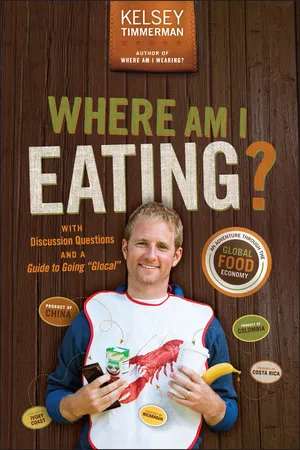
Where Am I Eating?
An Adventure Through the Global Food Economy with Discussion Questions and a Guide to Going "Glocal"
- English
- ePUB (mobile friendly)
- Available on iOS & Android
Where Am I Eating?
An Adventure Through the Global Food Economy with Discussion Questions and a Guide to Going "Glocal"
About This Book
A deeply human-centered perspective on the origins of America's food
Where Am I Eating? bridges the gap between global food producers and the American consumer, providing an insightful look at how our eating habits affect farmers and fishermen around the world. Follow the author on his global quest to meet the workers that nurture, harvest, and hunt our food, as he works alongside them—loading lobster diving boats in Nicaragua, harvesting bananas in Costa Rica, lugging cocoa beans in Ivory Coast with a modern-day slave, picking coffee beans in Colombia and hauling tomatoes in Indiana. This new edition includes a study guide, a deeper explanation of the "glocal" concept, and advice for students looking to become engaged as both local and global citizens. Arguing neither for nor against globalization, this book simply explores the lives of those who feed us.
Imports account for eighty-six percent of America's seafood, fifty percent of its fresh fruit, and eighteen percent of its fresh vegetables. Where Am I Eating? examines the effects of this reliance on those who supply the global food economy.
- Learn more about the global producers that feed our nation, and learn from their worldviews intensely connected to people and planet
- Discover how food preferences and trends affect the lives of farmers and fishermen
- Catch a boots-on-the-ground glimpse of the daily lives of food producers on four continents
- Meet a modern-day slave and explore the blurred line between exploitation and opportunity
- Observe how the poorest producers fare in the global food economy
This book takes a human-centered approach to food, investigating the lives of the people at the other end of the global food economy, observing the hope and opportunity—or lack thereof—that results from our reliance on imports. Where Am I Eating? is a touching, insightful, informative look at the origins of our food.
Frequently asked questions
Part I
Coffee: Product of Colombia
Chapter 1
The Starbucks Experience
How far do we go for a better cup of Colombian coffee?Six thousand feet—straight up. Sounds extreme, we know. But high atop the majestic Andes, in a rugged landscape of simmering volcanoes, is where the finest coffee beans in Colombia like to grow. And just as there are no shortcuts through the dirt paths that crisscross the sheer slopes, we take none when it comes to nurturing these treasured cherries to gourmet perfection.This Colombian marvel erupts on the palate with a juicy feel and robust flavors, a testament to the hearty riches of volcanic soils. Its remarkable finish, dry with hints of walnut, lifts this superior coffee into a class of its own. One sip and you'll agree it's worth every step of the climb.
Hello Kelsey,Thank you for contacting Starbucks.We appreciate your interest in Starbucks.Unfortunately, the information you are requesting is proprietary information, which we are unable to divulge. We're unable [to] provide information about the company beyond what we make publicly available.I apologize for any inconvenience this may cause.Thanks again for writing us. If you ever have any questions or concerns in the future, please don't hesitate to get in touch.Sincerely,[A customer service agent who will remain unnamed.]

Country of Origin Labeling is a labeling law that requires food retailers to notify their customers with information regarding the source of certain foods.1

Table of contents
- Cover
- Title Page
- Copyright
- Dedication
- Introduction: Our Global Connection
- Part I: Coffee: Product of Colombia
- Part II: Chocolate: Product of West Africa
- Part III: Banana: Product of Costa Rica
- Part IV: Lobster: Product of Nicaragua
- Part V: Apple Juice: Product of China
- Part VI: My Life: Product of USA
- Appendix A: A Guide to Ethical Labels
- Appendix B: The Journey Continues
- Appendix C: A Guide to Going Glocal
- Chapter Discussion Questions
- Acknowledgments
- End User License Agreement